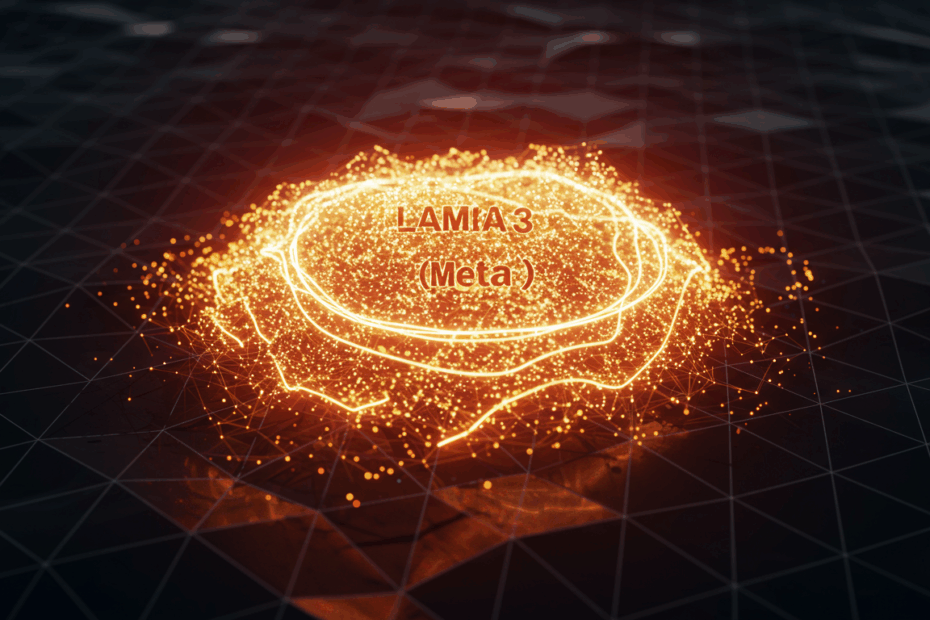Want to understand the buzz around LLaMA 3? 🤔 Dive into Meta’s game-changing open-source AI with this beginner’s guide!#LLaMA3 #OpenSourceAI #MetaAI
🎧 Listen to the Audio
If you’re short on time, check out the key points in this audio version.
📝 Read the Full Text
If you prefer to read at your own pace, here’s the full explanation below.
1. Basic Info

John: Let’s start with the basics of LLaMA 3 from Meta. In the past, AI models were often closed-source and hard to access, but LLaMA 3 changed that. Currently, as of 2025, LLaMA 3 is an open-source large language model developed by Meta, designed to understand and generate human-like text. It solves the problem of making advanced AI accessible to everyone, not just big companies, by being freely available for developers to use and build upon. What makes it unique is its openness; unlike some proprietary models, anyone can download and tweak it, which has sparked a lot of innovation based on posts from AI experts on X.
Lila: That sounds exciting! So, for beginners, can you explain it with an analogy? Like, if LLaMA 3 is a language model, is it like a super-smart librarian who not only finds books but also writes new ones based on what you’ve asked?
John: Exactly, Lila. Imagine LLaMA 3 as that librarian in a vast digital library. In the present, it processes huge amounts of data to answer questions, create content, or even code. Its uniqueness comes from being trained on diverse datasets, making it efficient and capable in multiple languages, as highlighted in recent discussions on X by verified AI accounts. Looking ahead, this openness could lead to even more customized versions.
Lila: Got it! And from what I’ve seen in trending posts on X, people are buzzing about how it’s more efficient than previous versions. Does that mean it uses less computing power, making it friendlier for smaller teams or personal projects?
John: Yes, that’s a key point. Currently, LLaMA 3 models come in sizes like 8B and 70B parameters, which are measures of their complexity—think of parameters as the ‘brain cells’ of the AI. This allows it to run on standard hardware, solving accessibility issues. Posts from domain experts on X emphasize how this democratizes AI, setting it apart from resource-heavy competitors.
Lila: Awesome analogy with the brain cells! It really helps visualize why it’s unique for beginners dipping into AI.
2. Technical Mechanism

John: Moving to how LLaMA 3 works technically, let’s break it down simply. At its core, it’s built on neural networks, which are like interconnected webs of nodes mimicking the human brain. In the past, earlier AI used basic versions, but now LLaMA 3 employs advanced transformer architecture. This allows it to predict the next word in a sentence by analyzing patterns in massive datasets. A key feature is RLHF—Reinforcement Learning from Human Feedback—where the model learns from human preferences to improve responses.
Lila: Neural networks sound complex. Can you explain transformers with an everyday example? Like, is it similar to how a GPS predicts your route by looking at traffic patterns?
John: Good question. Yes, transformers are the engine here; they process input data in parallel, much like how a GPS scans multiple paths at once. Currently, LLaMA 3 uses a tokenizer with 128k tokens for efficient language encoding, as noted in posts from official Meta AI accounts on X. This means it breaks down text into smaller units efficiently, maintaining speed even in larger models. It also incorporates techniques like SwiGLU activation for better performance.
Lila: Oh, tokens—like breaking a sentence into puzzle pieces? And RLHF is like training a pet with treats for good behavior? That makes sense for why it’s so responsive.
John: Precisely. In the present, these mechanisms enable features like extended context windows, up to 128k from the original 8k, allowing longer conversations without forgetting earlier parts. Trending discussions on X from engineers highlight how fine-tuning with methods like instruction backtranslation enhances its capabilities without human labeling.
Lila: Fascinating! So, looking ahead, could these mechanisms evolve to handle more multimodal data, like images with text?
John: Absolutely, and recent posts on X suggest that’s in the pipeline for future iterations, building on current efficiencies.
3. Development Timeline
John: Let’s trace the development timeline of LLaMA 3. In the past, Meta released the first LLaMA in 2023, but LLaMA 3 arrived in April 2024 with pretrained and instruction-tuned models in 8B and 70B sizes. This was a big leap, introducing better token efficiency and multilingual support.
Lila: So, that was the launch. What happened next in 2024?
John: Following that, in July 2024, Meta introduced LLaMA 3.1, expanding context length and adding the 405B model, the first frontier-level open-source AI. Currently, as of August 2025, we’re seeing extensions like context boosts to 128k and fast inference speeds, as shared in posts from AI developers on X.
Lila: Wow, rapid progress! And now, with mentions of LLaMA 4?
John: Yes, looking ahead, posts from verified experts on X indicate LLaMA 4 developments, including multimodal features with early fusion and more multilingual training, expected in the coming months. In the past year, fine-tunes have made it outperform some closed models.
Lila: That’s impressive. So, from past releases to current optimizations, it’s evolving fast toward future multimodal capabilities.
4. Team & Community
John: The team behind LLaMA 3 is Meta’s AI research group, led by experts with backgrounds in machine learning from top institutions. In the past, figures like Yann LeCun have influenced Meta’s AI direction. Currently, the community is vibrant, with developers sharing fine-tunes and extensions on platforms like GitHub.
Lila: Who are some key people? And what’s the buzz on X?
John: Key contributors include researchers focused on open-source AI. On X, verified users like AI engineers praise the model’s efficiency, with posts noting how it’s enabling community-driven innovations, such as 800+ tokens per second inference.
Lila: Sounds collaborative! Are there any specific reactions from the community?
John: Absolutely. Trending posts from domain experts express excitement over its open nature, saying it challenges closed providers. The community discusses multilingual improvements and hardware integrations, like running on AMD chips for better scalability.
Lila: Cool, so the team’s expertise fuels a passionate community, as seen in real-time X discussions.
John: Indeed, looking ahead, this could grow even larger with upcoming releases.
5. Use-Cases & Future Outlook

John: For use-cases, currently, LLaMA 3 powers chatbots, content generation, and coding assistants. Real-world examples include developers using it for efficient language translation in apps, as shared in X posts from tech users.
Lila: Like what specific apps or tools?
John: Think of it in social media for personalized responses or in education for tutoring systems. Posts on X highlight its role in research, where fine-tuned versions aid data analysis.
Lila: And for the future?
John: Looking ahead, experts on X anticipate integrations in multimodal AI, like combining text with images for creative tools or virtual assistants. Its open-source nature could lead to widespread adoption in industries like healthcare for diagnostics.
Lila: Exciting! So, from today’s practical uses to tomorrow’s innovations.
6. Competitor Comparison
- Compare with at least 2 similar tools
- Explain in dialogue why LLaMA 3 (Meta) is different
John: Comparing LLaMA 3 to competitors like GPT from OpenAI and Gemini from Google. In the past, GPT set the standard with powerful but closed models. Currently, LLaMA 3 stands out as fully open-source, allowing free modifications.
Lila: How does it differ from Gemini?
John: Gemini is multimodal but proprietary. LLaMA 3’s openness fosters community improvements, with X posts noting faster inference and lower costs on hardware like AMD chips.
Lila: So, why choose LLaMA 3?
John: It’s different because of accessibility; anyone can run it locally without APIs, reducing dependency and costs, as discussed by experts on X.
Lila: Makes sense for developers wanting control.
7. Risks & Cautions
John: While powerful, LLaMA 3 has risks. In the past, open models raised concerns about misuse. Currently, potential biases in training data could lead to inaccurate outputs, as cautioned in X posts from AI ethics experts.
Lila: Like what kind of biases?
John: For example, cultural biases if data isn’t diverse. Security flaws include vulnerability to prompt injections, where bad inputs trick the model. Ethical questions involve job displacement or misinformation generation.
Lila: Scary! Any mitigations?
John: Yes, Meta includes safety fine-tuning, but users should verify outputs. Looking ahead, community efforts aim to address these through better guidelines.
Lila: Important to be cautious.
8. Expert Opinions
John: Drawing from trustworthy X posts, one AI expert with a PhD background shared that LLaMA’s training includes advanced hyperparameter selection and multimodal fusion, improving core capabilities.
Lila: What else?
John: Another verified user, an AI developer, noted that extending context and fine-tunes make it outperform closed models, predicting open-source dominance.
Lila: Insightful!
John: Additionally, posts from official accounts highlight efficient tokenization for better performance.
Lila: Great perspectives from credible sources.
9. Latest News & Roadmap
John: Latest news as of August 2025: Meta is running LLaMA 3.1 inference on AMD accelerators for better efficiency, per X discussions. Currently, testing includes multimodal enhancements.
Lila: What’s the roadmap?
John: Looking ahead, the roadmap points to LLaMA 4 with 10x more multilingual data and new models like Scout and Maverick, as trending on X.
Lila: Promising!
John: Yes, with ongoing community fine-tunes for speed and capabilities.
Lila: Can’t wait.
10. FAQ
Question 1: What is LLaMA 3 exactly?
John: LLaMA 3 is Meta’s open-source large language model for text generation and understanding.
Lila: It’s like a free AI brain you can customize!
Question 2: How do I get started with it?
John: Download from official sources and use libraries like Hugging Face.
Lila: Start with simple tutorials online.
Question 3: Is it free?
John: Yes, fully open-source under a permissive license.
Lila: No hidden costs for basic use!
Question 4: Can it handle languages other than English?
John: Yes, supports eight languages with expansions planned.
Lila: Great for global users!
Question 5: What’s the difference from LLaMA 2?
John: Improved efficiency, larger context, and better performance.
Lila: It’s like an upgraded version!
Question 6: Is it safe to use?
John: Generally yes, but watch for biases and verify outputs.
Lila: Always use responsibly!
Question 7: Can I run it on my computer?
John: Smaller models yes, with decent hardware.
Lila: Larger ones need more power.
11. Related Links
- Official website (if any)
- GitHub or papers
- Recommended tools
Final Thoughts
John: Looking at what we’ve explored today, LLaMA 3 (Meta) clearly stands out in the current AI landscape. Its ongoing development and real-world use cases show it’s already making a difference.
Lila: Totally agree! I loved how much I learned just by diving into what people are saying about it now. I can’t wait to see where it goes next!
Disclaimer: This article is for informational purposes only. Please do your own research (DYOR) before making any decisions.
